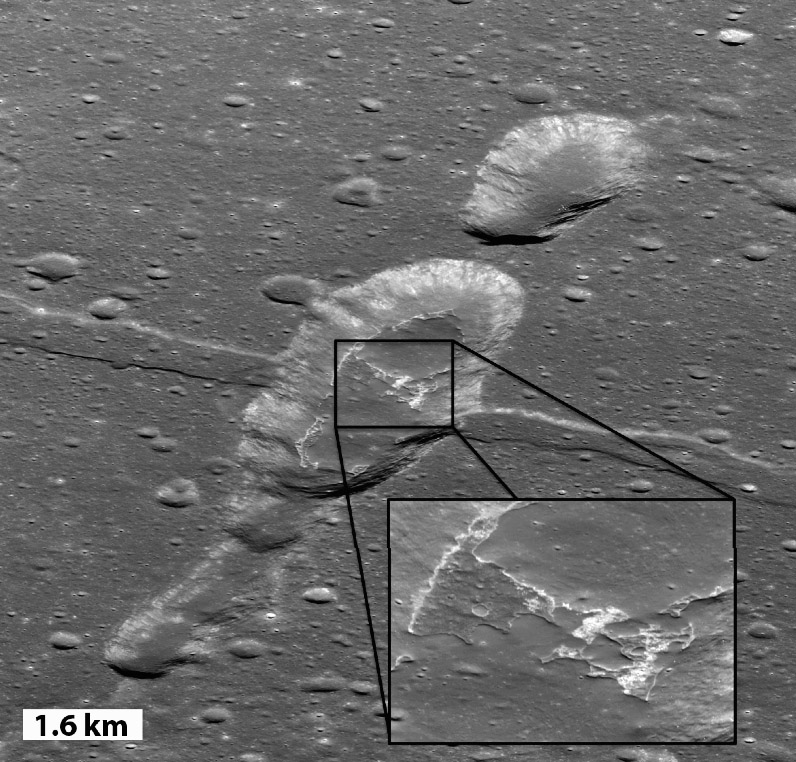October 15, 2014
Turning Understanding On Its Head

LRO image of Sosigenes ISP from Braden and colleagues in Nature Geoscience. This depression has been imaged by amateurs.
The superb high resolution of the Lunar Reconnaissance Orbiter cameras has resulted in the discovery of all sorts of sub-km scale features. Most refine and extend existing understanding, but a new paper by the LROC team in Nature Geoscience challenges a fundamental understanding of the Moon's late stage thermal history. But only if the interpretation is correct; I have concerns. LRO images resulted in the discovery of 70 irregular mare patches (IMPs), the average about 500 m across. The best known of these is the odd and young feature Ina, discovered by Apollo, and which is a collapsed area at the summit of a volcanic dome. Ina and the other IMPs have two types of terrain. One terrain has an uneven surface that is rough and blocky. Smooth terrain is stratigraphically and topographically on top of the uneven material. Counts of craters typically 10-100 m in diameter give ages for three smooth terrains of 18 to 58 million years. This is old by many Earth standards, but almost unbelievably young compared to recognized volcanism on the Moon. The dated volcanic rocks from Apollo missions are typically 3.6 to 2.5 billion years old, and the youngest volcanic flows based on prior crater counting are about 1 billion years old, about 50 times older than the IMPs. The crater count evidence and sharpness of small features are strong evidence for a very young age for the IMPs. The real question is are these volcanic deposits or something else? The LROC team interprets them as the products of very recent volcanic eruptions based on 4 types of evidence. 1) The 8 m average thickness of the smooth terrains is within the range of previously measured lunar lava flows. 2) The smooth material has lobate margins and steep boundary slopes - lobate slopes are characteristic of flowing material. 3) IMPs are associated with volcanic vents. 4) Multispectral data are consistent with known lunar lavas. These are remarkably weak evidences for an interpretation that has such important consequences for lunar evolution! Evidences 1) and 4) are nearly trivial; 2) and 3) are critical. But the purported lobate margins of the smooth materials are not lobate as usually seen in volcanic materials on Venus, Earth, the Moon, Mars and Io. The margins are gently rounded, not what would usually be called lobate, and nowhere did I notice flow-like structure on the surfaces. Likewise, in looking at the 70 images in the Supplementary Materials I saw only one possible vent - #46 has a hill with a pit on top. The margins of the smooth material - in the Sosigenes IMP above and all the others - look like a flowing surface restrained by surface tension (the smooth material within Ina looks like beaded drops of water) and there are no obvious flow lineations. Additionally, what is the origin of the depressions that the IMPs occur in? If IMPs are to be accepted as volcanic flows the evidence must be much more conclusive before accepting a need to change thermal evolution models.
Chuck Wood
Related Links
21st Century Atlas chart 12.
S. E. Braden, J. D. Stopar, M. S. Robinson, S. J. Lawrence, C. H. van der Bogert and H. Hiesinger. (2014) Evidence for basaltic volcanism on the Moon within the past 100 million years. Nature Geoscience. Published online Oct 12, 2014.
Yesterday's LPOD: Two Are Better Than One
Tomorrow's LPOD: Two Lunar Brothers
COMMENTS?
Register, Log in, and join in the comments.



